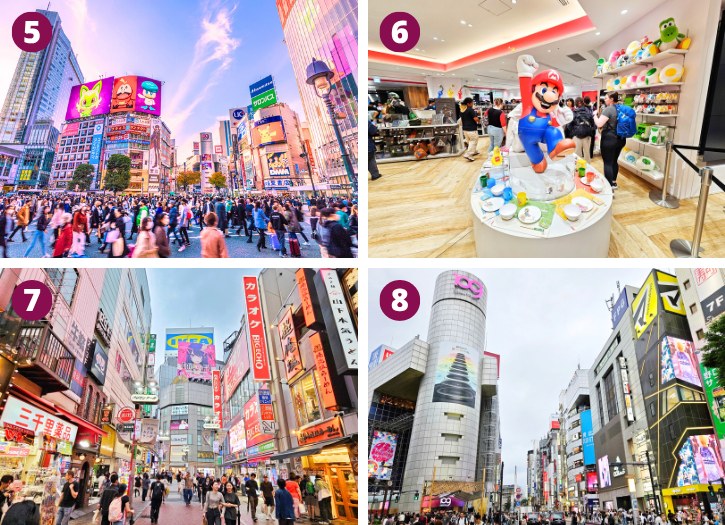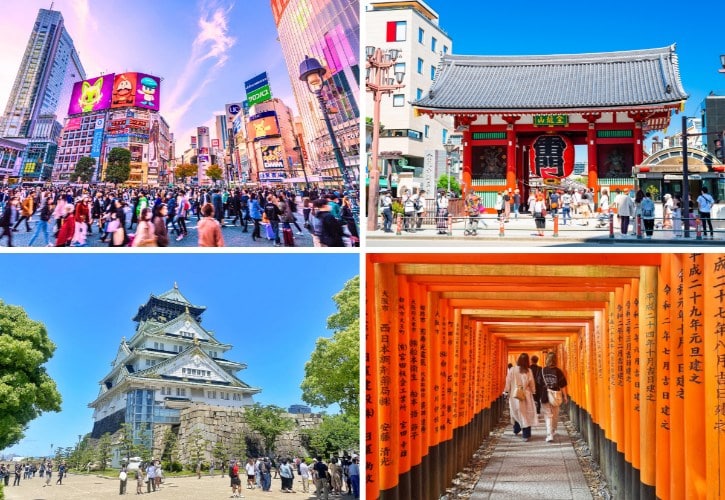
Planning your first trip to Japan?
This 10-day itinerary gives you the best of Japan’s big three: Tokyo’s modern energy, Osaka’s food culture, and Kyoto’s traditional beauty.
You’ll see the iconic spots, taste incredible food, and still have time to wander.
No fluff. No rushing. Just the highlights that matter most. Japan is waiting. Go make it unforgettable. 😊
Day 1: Shinjuku (Tokyo)
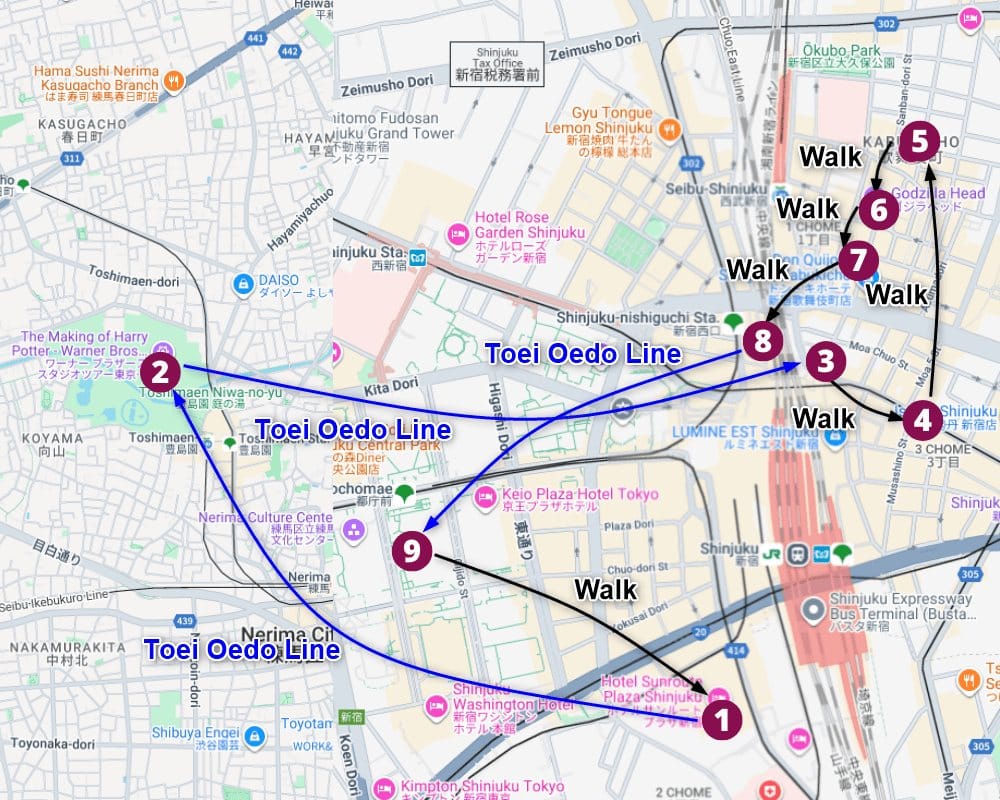
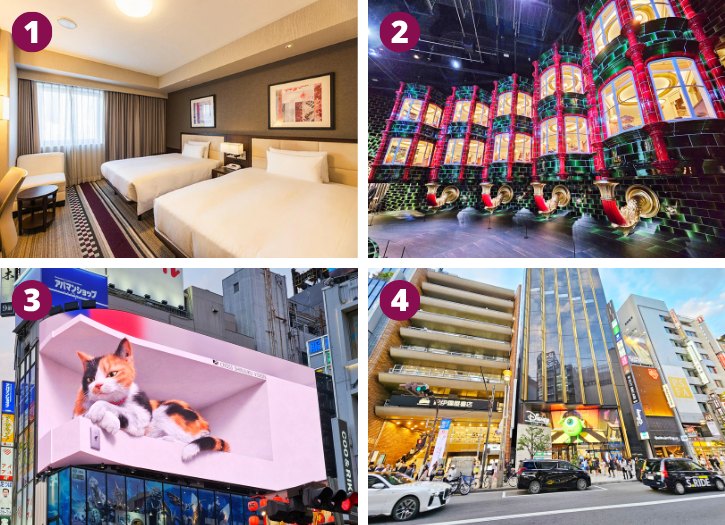
1. Check in at Hotel Sunroute Plaza (10:00 AM)
- Just 3 minutes from JR Shinjuku Station South Exit
- Direct airport buses to both Haneda and Narita
Read More:
2. Warner Bros. Studio Tour Tokyo + Lunch (11:30 AM)
The Warner Bros. Studio Tour Tokyo is a must-visit for Harry Potter fans.
What You’ll Experience:
- Walk through the iconic Great Hall with its long dining tables and floating candles
- Explore Diagon Alley’s cobblestone streets and shop windows
- Step onto the Hogwarts Express and peek inside the train compartments
- See the intricately detailed Hogwarts castle model used in filming
- Learn about special effects, creature design, and wand choreography
3. 3D Cat Billboard in Shinjuku (4:00 PM)
- Giant calico cat with different animations throughout the day
- Special 15-minute shows with extended sequences
- Operating hours: 7 AM – 1 AM daily
- Location: Near Shinjuku Station East Exit
4. Shinjuku Shopping Street & Disney Flagship Store Tokyo (4:30 PM)
Disney Flagship Store Tokyo:
- Japan’s largest Disney store
- Exclusive Disney, Pixar, Marvel, and Star Wars merchandise
Other Shopping Options:
- Kinokuniya Shinjuku Main Store: Nine floors of books, magazines, comics, stationery
- Matsumoto Kiyoshi: Tax-free cosmetics and drugstore items
- UNIQLO Shinjuku Honten: Flagship store with comprehensive selection
- ABC-MART: Japan-exclusive sneakers and multiple brands
- Isetan Shinjuku: High-end fashion with excellent basement food hall
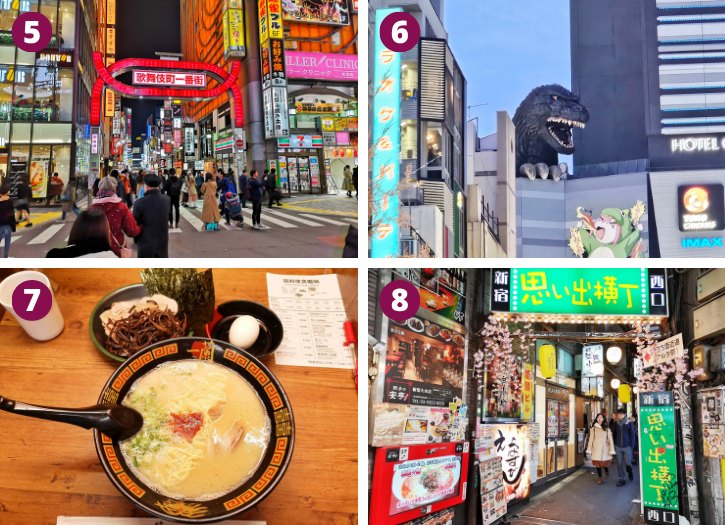
5. Kabukicho (5:30 PM)
- Japan’s most vibrant entertainment hub
- Famous Kabukicho Gate with red neon lights
- Safety tip: Decline bar/club invitations from touts, check menu prices before entering
6. Godzilla Street & Godzilla Head (6:00 PM)
- Giant Godzilla head on Hotel Gracery
- Hourly shows from 12 PM – 8 PM
- Features: Glowing eyes and smoke effects
7. Ichiran Shinjuku Kabukicho – Dinner (6:30 PM)
- Specialty: Tonkotsu ramen with customizable options via vending machine
- Budget: ¥1,000-1,500 per person
Alternative: Hinomaru | Hakata Tenjin Ramen | Sushizanmai
8. Omoide Yokocho (7:30 PM)
- Historic narrow alley from post-war Tokyo
- Small bars and eateries preserve authentic culture
- Try: Yakitori (grilled chicken skewers), Horumon (grilled offal) and Nikomi (beef tendon stew)
9. Tokyo Night & Light (8:30 PM/ 9:00 PM)
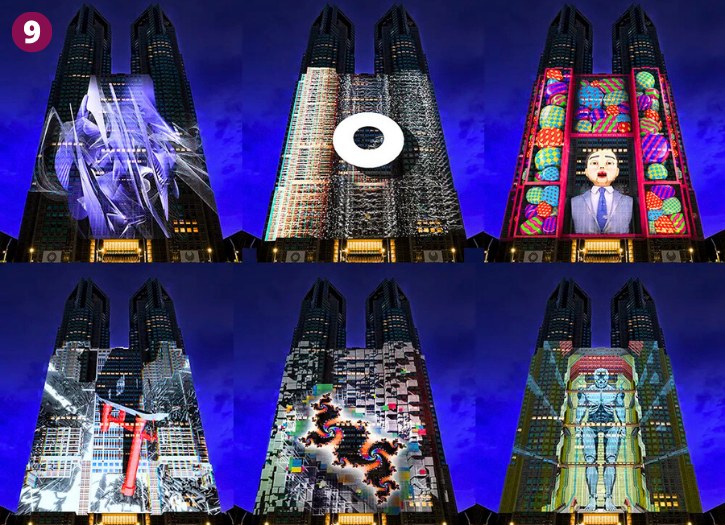
- Show times: 6:30 PM – 9:30 PM
- Duration: 10 minutes per show
- World record: 13,905 square meters (largest permanent display)
- Different shows on weekdays vs. weekends/holidays
- Best viewing spot: Citizens’ Plaza
- Completely free
Day 2: Harajuku and Shibuya (Tokyo)
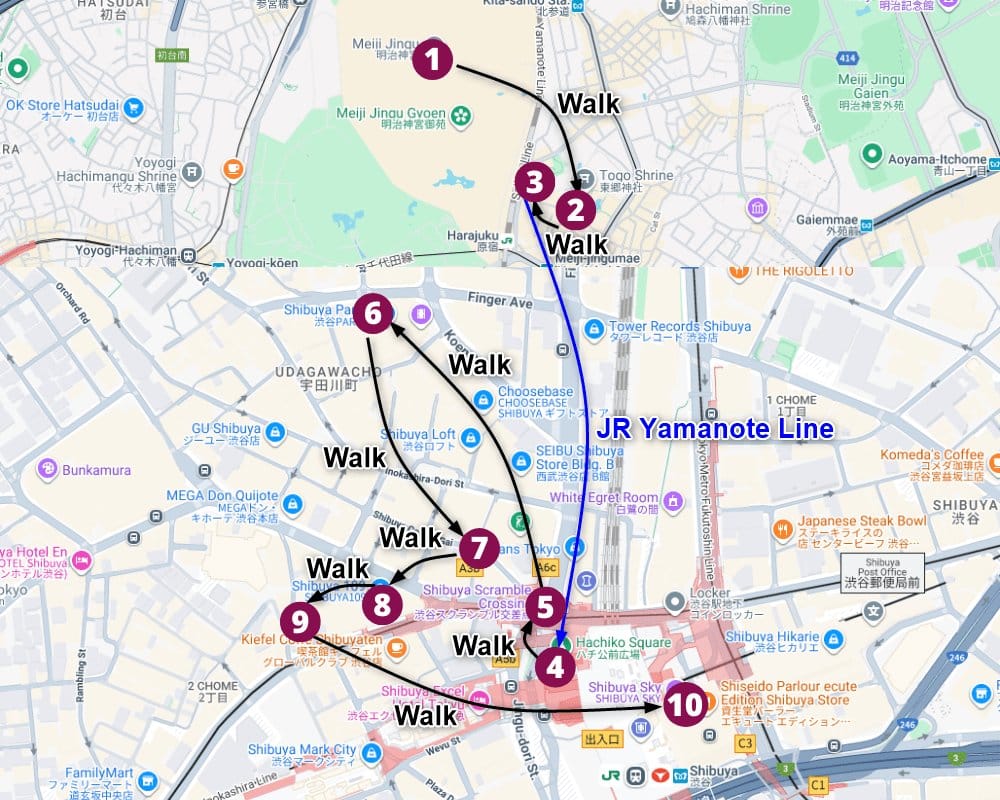
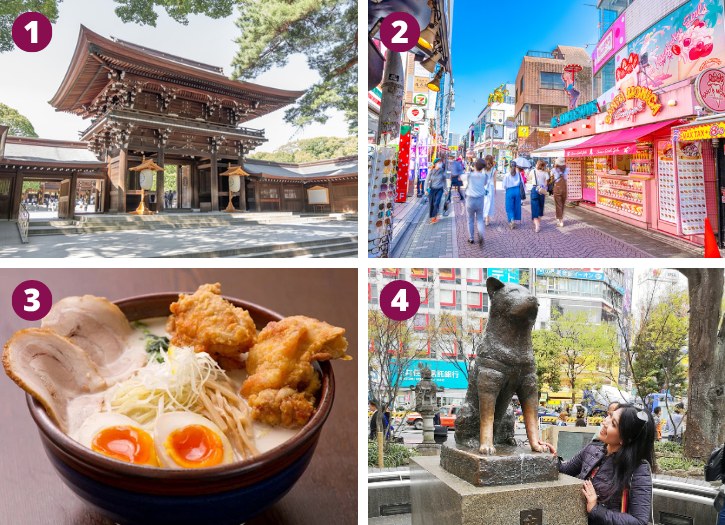
1. Meiji Shrine (10:00 AM)
- One of Tokyo’s most important Shinto shrines
- Attracts over 3 million visitors during New Year
- Set in a peaceful man-made forest
- See: 12-meter wooden torii gates, main shrine building, sake and wine barrel displays, and the surrounding sacred forest
- Do: Perform purification at the fountain, write wishes on wooden ema plaques, watch traditional weddings if lucky, and enjoy a relaxing forest walk
2. Takeshita Street (11:30 AM)
Key Highlights:
- Vintage clothing stores with one-of-a-kind pieces
- Kawaii accessories and knick-knacks
Must-Try Street Food:
- Marion Crepes: Sweet and savory options
- Totti Candy Factory: Instagram-famous rainbow cotton candy
- Long! Longer!! Longest!!!: Tornado potato (crispy spiral-cut)
3. Oreryū Shio Ramen Harajuku Ekimae – Lunch (12:30 PM)
- Specialty: Salt-flavored ramen with customizable toppings
- Budget: ¥780
Alternative: Gyukatsu Motomura | Roast Beef Ohno
4. Hachiko Statue (1:30 PM)
- Famous loyal Akita dog who waited 9 years for his owner
- First statue built 1934, current statue from 1948
- Popular meeting spot
5. Shibuya Crossing (1:45 PM)
- World’s busiest crossing
- Up to 3,000 people crossing at once
- All traffic stops, pedestrians cross from every angle
- Featured in movies and TV shows worldwide
Best Viewpoints:
- Second-floor Starbucks (arrive early for window seats)
- Shibuya Sky deck at Shibuya Scramble Square
- Magnet by Shibuya 109 rooftop observation deck
- Hoshino Coffee inside 109 MEN’S
6. Nintendo Tokyo and Pokemon Center Shibuya (2:00 PM)
Both located on 6th floor of Shibuya PARCO.
Nintendo Tokyo:
- Exclusive Nintendo merchandise unavailable elsewhere
- Items from Super Mario, Legend of Zelda, Animal Crossing
- Life-sized character statues (Splatoon Inkling Girl, Mario) for photos
- Demo stations for latest Nintendo Switch games
- Impressive displays and decorations throughout
Pokémon Center Shibuya:
- Large animatronic Mewtwo in hibernation tube at entrance
- Urban-inspired design different from other Pokémon Centers
- Interactive touch-panels and giant graffiti-covered Pikachu
- Wide selection of plush toys including regional exclusives
- Pokémon-themed clothing with streetwear vibe
- Trading cards and game-related products
7. Shibuya Center-gai (3:30 PM)
Bustling shopping street with neon signs and energetic crowds.
Shopping Options:
- Shibuya 109: 10 floors, 120+ stores of trendsetting women’s fashion
- Mega Don Quijote: Multi-story discount store (snacks to electronics)
- Disney Store: Official merchandise and souvenirs
- H&M, ZARA: International fast-fashion brands
- Uniqlo, GU: Japanese fashion chains
- Bic Camera: Electronics and gadgets
8. Shibuya 109 (5:00 PM)
- 10 floors of fashion, beauty products, accessories
- Over 120 stores catering to various styles
- Both local and international brands
- Vibrant atmosphere with loud music and energetic staff
9. Uobei Shibuya Dogenzaka – Dinner (6:30 PM)
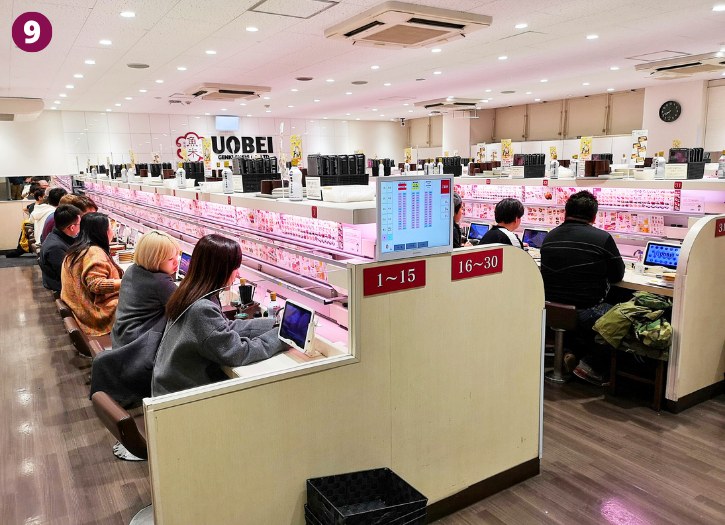
- Specialty: Conveyor belt sushi with English tablet ordering
- Must-try: Grilled Salmon with Pepper Mayo, Grilled Shrimp and Cheese, Seared Albacore
- Budget: ¥1,000-1,500 per person
10. Shibuya Sky (7:30 PM)
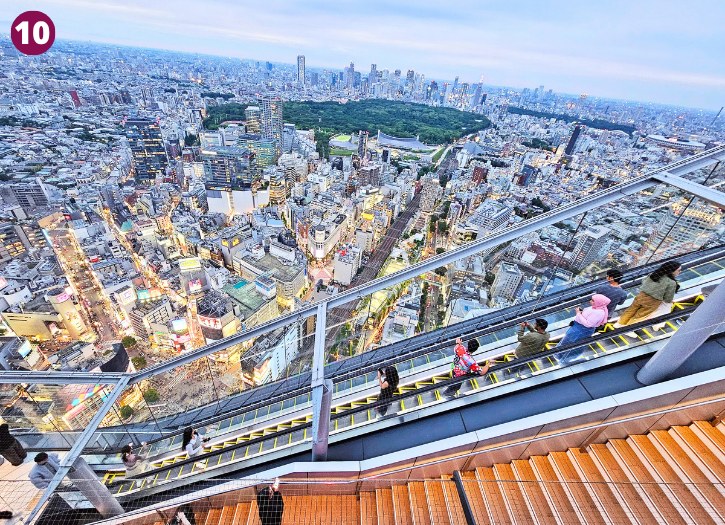
Overview:
- Tokyo’s highest open-air observation deck
- Height: 229 meters (751 feet)
- Features: 360° city views, indoor and outdoor areas
Sky Gate (14F):
- Take elevator from ground floor to 14F
- Find Shibuya Sky entrance
- Take high-speed elevator to 45F
- Watch “Transition” digital art show during ride
Sky Gallery (46F):
- Store belongings in ¥100 lockers (coin refunded)
- Enjoy floor-to-ceiling windows with city views
- Interact with digital art displays
Sky Stage (Rooftop):
- Complete 360° views
- Spot Tokyo Tower, Tokyo Skytree, Mt. Fuji
- Look down at Shibuya Crossing
- Try “Cloud Hammock” floating above city
- “Sky Edge” corner perfect for photos
Planning Tips:
- Book online 4 weeks ahead for best time slots
- Cameras allowed (no tripods, selfie sticks, or monopods)
- Best times: Sunset for golden hour, nighttime for city lights
- Watch for 3D show in elevator
Read More: 17 Top Things to Do in Shibuya with My Ideal Itinerary
Day 3: Tokyo Disneyland or DisneySea (Tokyo)
Tokyo Disneyland:
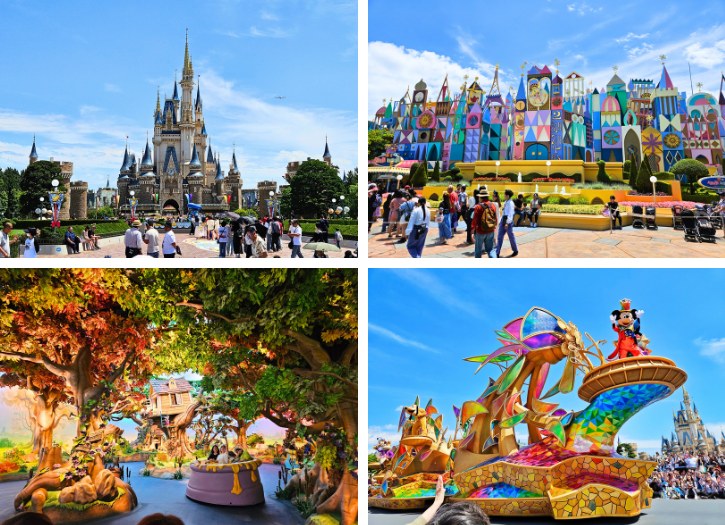
- Classic Disney experience with Japanese touches
- Familiar rides: Space Mountain, It’s a Small World
- Unique snacks: Curry-flavored popcorn
Tokyo DisneySea:
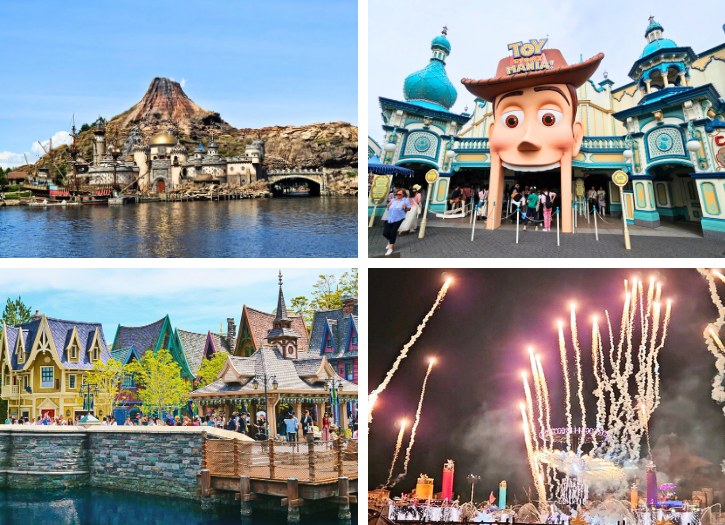
- One-of-a-kind Disney park (exists nowhere else)
- More grown-up atmosphere
- New Fantasy Springs area: Frozen, Tangled, Peter Pan worlds
- Beautiful Mediterranean harbor theme
Why Buy Disneyland or DisneySea Tickets Online
Book your tickets online in advance to skip the long lines and guarantee your entry. Keep in mind, tickets are no longer sold at the parks.
How to Get to the Disney Parks
I’ve put together a detailed guide with step-by-step directions and photos on how to reach both Tokyo Disneyland and DisneySea. You can check it out here before your visit.
Read More: Tokyo Disneyland vs DisneySea
Day 4: teamLab Borderless and Asakusa (Tokyo)
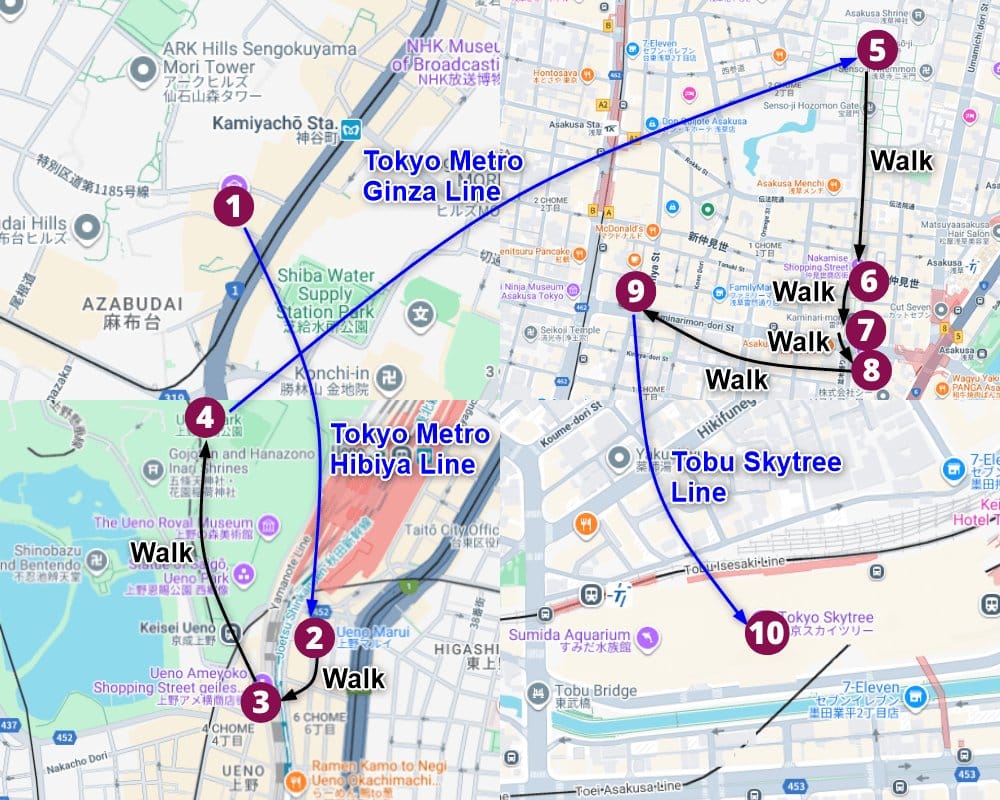
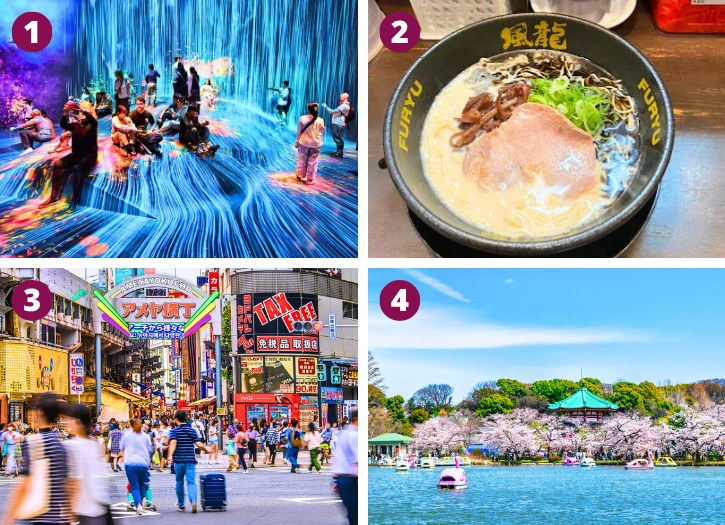
1. teamLab Borderless (Azabudai Hills) (9:30 AM)
Overview:
- Over 50 interactive artworks flowing into each other
- No fixed routes or time limits
- Art changes and interacts with visitors
- Blend of art, science, technology, and nature
Key Exhibits:
- Bubble Universe: Floating, glowing spheres of light
- Light Sculpture: Massive illuminated structures that move toward you
- Sketch Ocean: Create sea creatures that come alive in virtual ocean
- Borderless World: Ever-changing digital space where artwork flows and transforms
Planning Details:
- Duration: Plan 2-3 hours to fully enjoy
- Tickets: Book online in advance—sell out quickly
- Dress code: Avoid baggy shorts or skirts (mirrored floors)
- Clothing: Choose darker colors for better art reflections
2. Hakata Furyu Ueno – Lunch (12:00 PM)
- Specialty: Hakata-style tonkotsu ramen with rich, creamy pork bone broth and thin noodles
- Budget: ¥1,000-1,500 per person
Alternative: Miura Misaki Port Ueno | Nadai Unatoto | Ramen Kamo to Negi Ueno Okachimachi Main Store
3. Ameya Yokocho (1:00 PM)
- Bustling street market in Tokyo, nicknamed “Ameyoko”
- About 400 meters long with around 400 shops
- Once a black market after WWII, now a lively shopping street
- Shopping: Fresh seafood, dried goods, discount clothing, shoes, cosmetics, sweets, snacks, international foods, sporting goods, and bags
- Atmosphere: Crowded and energetic with loud vendors calling out deals, blending traditional Japanese stalls with international shops
4. Ueno Park (2:00 PM)
Overview:
- One of Tokyo’s largest public parks
- Established 1873 as Japan’s first public park
- 133 acres of green space in central Tokyo
- Home to museums, zoo, temples, and ponds
Cherry Blossoms (Spring):
- Over 1,000 cherry trees
- One of Tokyo’s most popular hanami (flower viewing) spots
- Best time: Late March to early April
Shinobazu Pond:
- Large natural pond in park’s center
- Lotus flowers bloom in summer
- Boat rentals available
- Beautiful walking paths around pond
Temples and Shrines:
- Kiyomizu Kannon-do Temple: Peaceful temple with views
- Toshogu Shrine: Ornate shrine with gold leaf decorations
- Bentendo Temple: Located on island in Shinobazu Pond
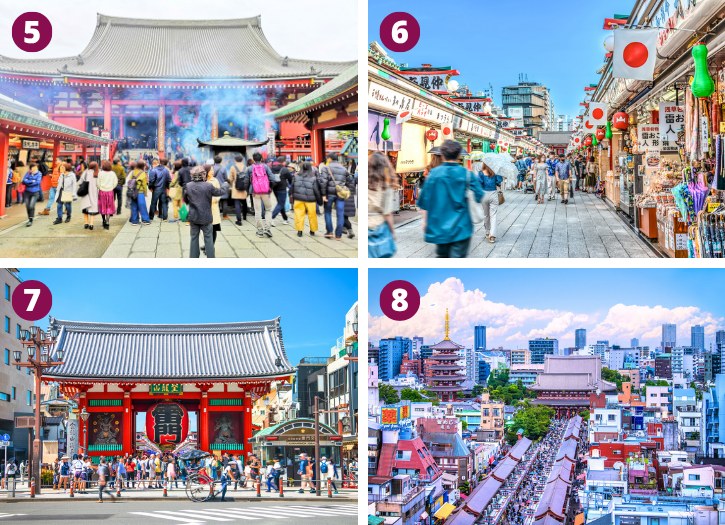
5. Sensoji Temple (3:30 PM)
- Japan’s most ancient temple (established 628 CE)
- 55-meter five-story pagoda
- Dedicated to Kannon, goddess of mercy
- Pass through Hozomon Gate with guardian figures
- Photograph the five-story pagoda
- Visit main hall (Hondo) for prayers and ceiling artwork
- Wave incense smoke over yourself at burner for good fortune
6. Nakamise Shopping Street (4:00 PM)
Overview:
- One of Japan’s oldest shopping streets (1700s)
- 250 meters long with 90 traditional shops
- Perfect mix of old and new Japanese souvenirs
Must-Try Street Foods:
- Dango (Asakusa Soratsuki): Colorful mochi skewers topped with fresh strawberries and sweet bean paste
- Ningyo Yaki (Kimuraya): Sweet bean-filled cakes shaped like dolls and landmarks
- Kibi Dango (Kibidango Azuma): Soft rice cakes with soybean powder coating
- Age Manju (Asakusa Kokonoe): Hot fried buns with red bean, matcha, or chocolate filling
- Rice Crackers (Tokiwado Kaminari-okoshi Honpo): Fresh-grilled crackers in various flavors
- Melon Pan (Kagetsudo): Sweet bread with crispy sugar coating
7. Kaminarimon Gate (5:30 PM)
- Built 941 AD, one of Tokyo’s oldest landmarks
- Massive 700kg red lantern (symbol of Asakusa)
- Guardian statues: Fūjin (wind god) and Raijin (thunder god)
- Gateway to Sensoji Temple
8. Asakusa Culture Tourist Information Center (5:40 PM)
- Unique architecture by Kengo Kuma (stacked wooden buildings)
- Free observation deck on 8th floor
- Panoramic views of Kaminarimon Gate, Sensoji Temple, Tokyo Skytree
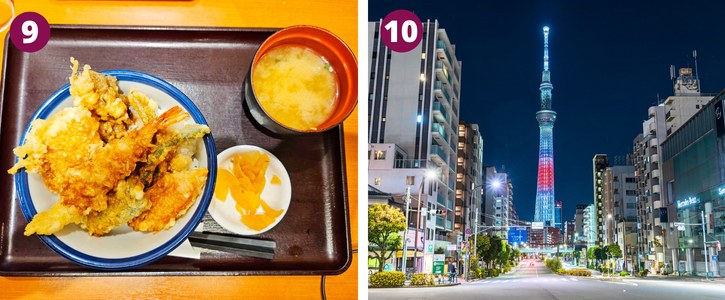
9. Tendon Tenya – Dinner (6:30 PM)
- Specialty: Tempura rice bowls with freshly fried seafood and vegetables
- Must-try: All-Star Tendon, Excellent Prawn and Squid Tendon, Irodori Tendon
- Budget: ¥750-1,500 per person
10. Tokyo Skytree (8:00 PM)
Overview:
- Japan’s tallest structure: 634 meters (2,080 feet)
- Iconic symbol of Tokyo’s skyline since 2012
- Unparalleled 360-degree views from observation decks
Tembo Deck (350 meters):
- Three floors with panoramic views
- Glass floor sections for thrilling look straight down
- Digital telescopes for close-up views of landmarks
Tembo Galleria (450 meters):
- Spiral ramp gradually ascends for changing perspectives
- Even more expansive views than Tembo Deck
- Unique sloping floor design
Day 5: Mount Fuji or Kawagoe Day Trip from Tokyo
Option 1: Mount Fuji Day Trip
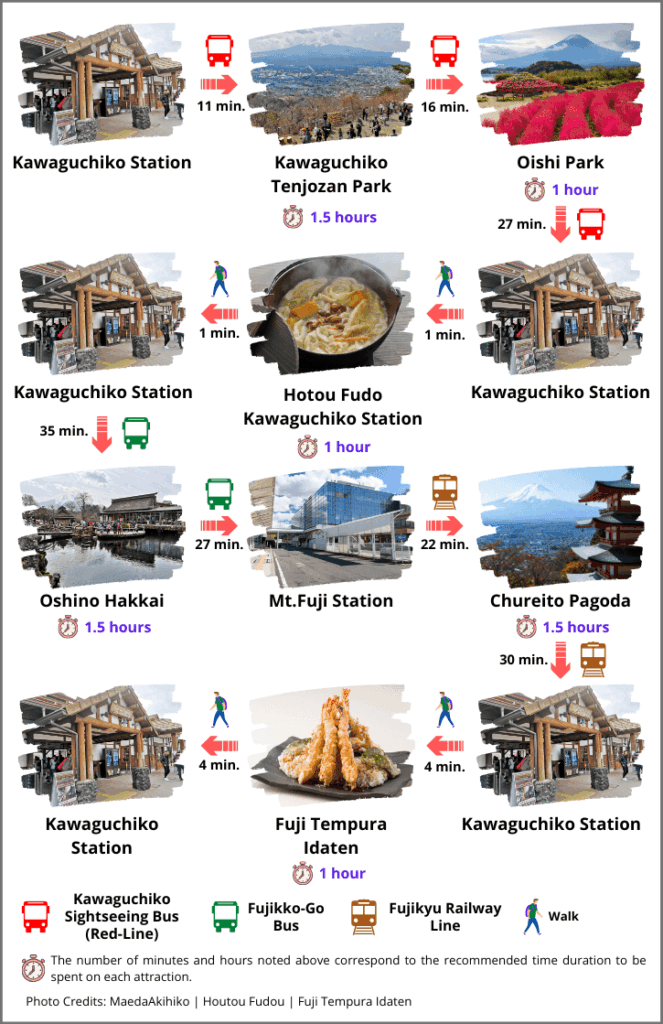
- Japan’s most iconic mountain at 3,776 meters
- UNESCO World Heritage Site
- Best views on clear days (visibility not guaranteed)
- Sacred mountain and symbol of Japan
Read More: The Complete Mount Fuji Day Trip Guide from Tokyo
Option 2: Kawagoe Day Trip
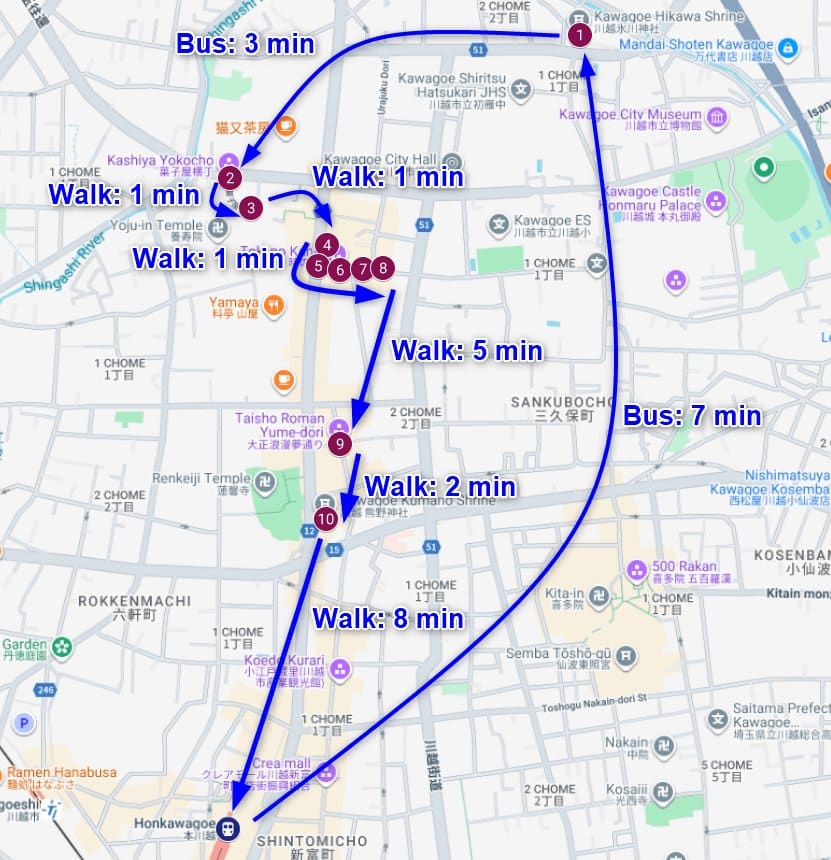
- Just 30-60 minutes from Tokyo
- Compact town with Edo-style warehouses
- Famous shrines and delicious street food
- Nicknamed “Little Edo”
Read More: The Best Kawagoe Day Trip Guide from Tokyo
Day 6: Tokyo to Osaka – Umeda and Osaka Castle
Tokyo to Osaka (9:30 AM)
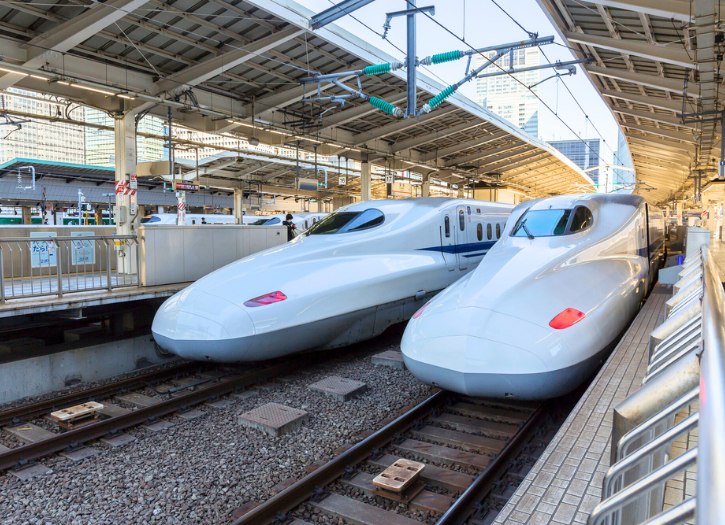
- Route: Tokyo to Osaka via Shinkansen
- Duration: About 2.5 hours
Read More: 3 Best Ways to Get to Osaka from Tokyo
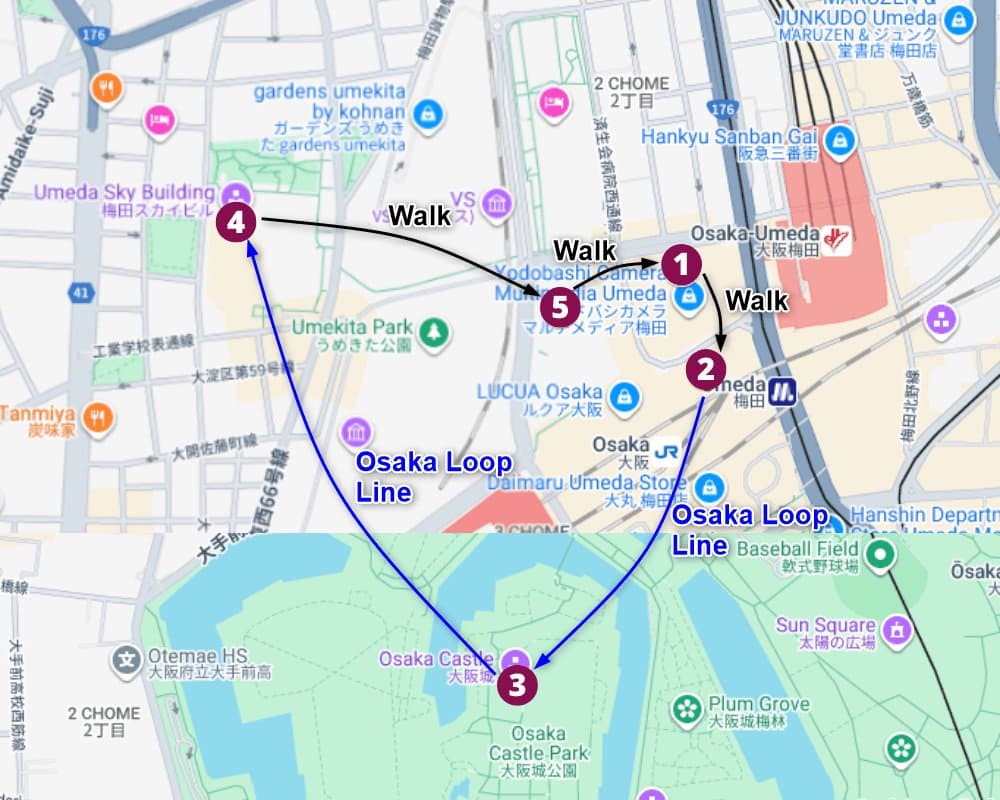
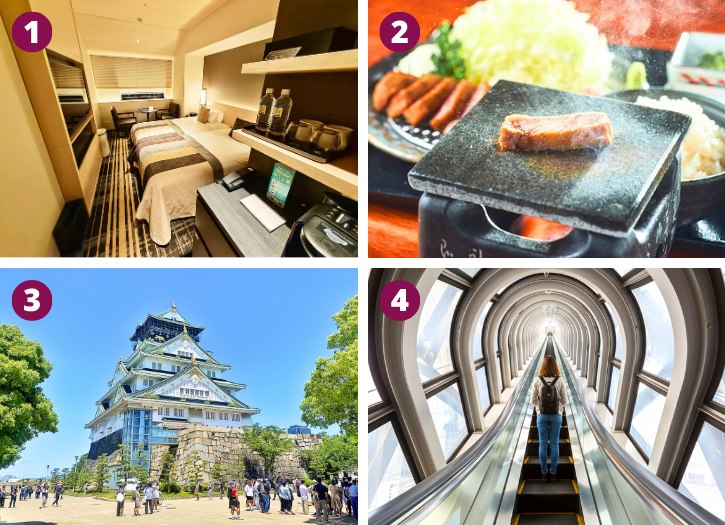
1. Check in at Hotel Hankyu RESPIRE OSAKA (1:00 PM)
- Conveniently located near Osaka Station
- Easy access to city attractions and transportation
Read More: 10 Best Hotels in Osaka
2. Gyukatsu Motomura – Lunch (2:00 PM)
- Specialty: Breaded beef cutlets (gyukatsu), crispy outside, rare inside, grilled on hot stone at your table
- Budget: ¥1,930-3,060 per person
3. Osaka Castle (3:30 PM)
- Famous Japanese landmark symbolizing rich history and cultural heritage
- Built 1586 by Toyotomi Hideyoshi as power symbol
- Faced numerous battles including Siege of Osaka
- Enjoy stunning 360-degree views of modern Osaka from the 8th floor
Seasonal Scenery
- Park is large and beautiful, especially during cherry blossom season (late March to early April)
- Autumn colors spectacular in November
4. Umeda Sky Building (6:30 PM)
Overview:
- 173-meter skyscraper with twin 40-story towers
- Connected by Kuchu Teien Observatory (“Floating Garden”)
- Recognized among world’s top 20 buildings (2008)
- Designed by Hiroshi Hara (1993)
Kuchu Teien Observatory Highlights
- Arrival (35F): Ride the elevator to the 35th floor, then transfer to the famous glass-enclosed escalators.
- Glass Escalators (35F–39F): Glide between towers with dramatic city views.
- Indoor Observatory (39F): Panoramic windows, gift shop, and access to cafés and restaurants.
- Sky 40 Café (40F): Relax with drinks, snacks, and international beers while enjoying wide-window views.
- Open-air Rooftop (173m): The “Floating Garden” offers stunning 360° views, ideal for photos and fresh air.
- Night (Lumi Sky Walk): Rooftop floor glows with illuminated patterns, creating a magical nighttime experience.
Takimi Koji (B1F): Retro-style underground street with restaurants serving Osaka favorites.
5. Hakodate Gourmet Kaitenzushi Kantaro Grand Front Osaka – Dinner (8:00 PM)
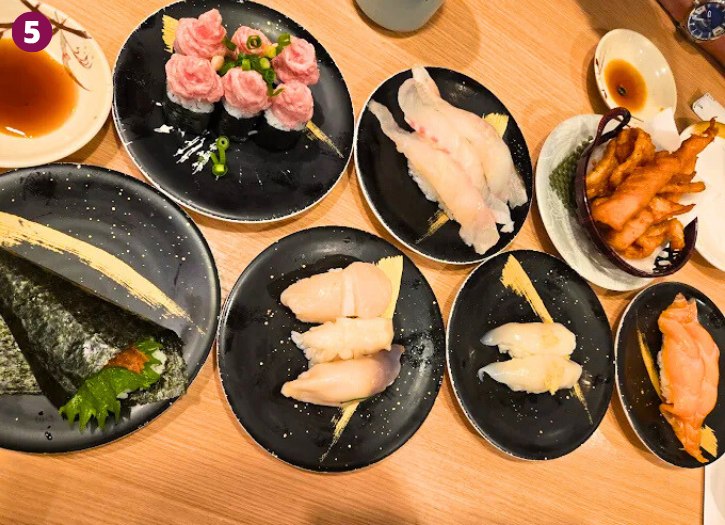
- Specialty: Conveyor-belt sushi with fresh Hokkaido seafood
- Budget: ¥3,000-4,000 per person
Alternative: Menya Takei Hankyu Umeda | Ichiran Umeda Shibata
Day 7: Universal Studios Japan (Osaka)
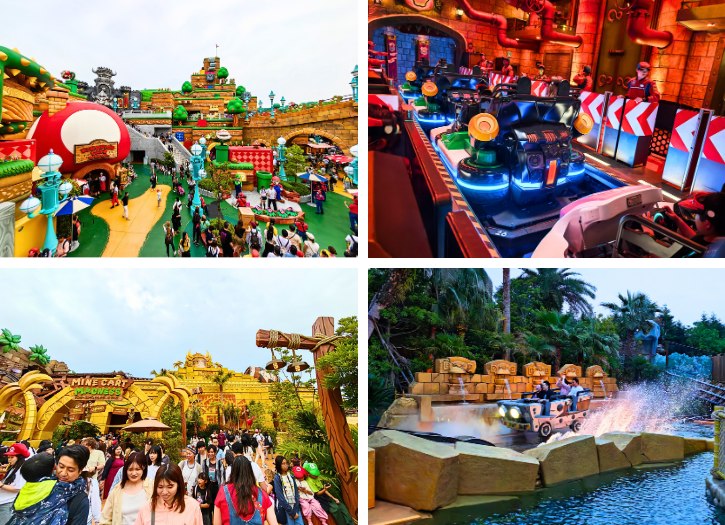
Universal Studios Japan is a popular theme park in Osaka offering rides and attractions based on movies, games, and Japanese pop culture.
Best Rides
- The Flying Dinosaur: Face-down coaster in Jurassic Park with loops and high speeds.
- Harry Potter and the Forbidden Journey: Motion-simulator through Harry Potter’s world, no big drops but very exciting.
- Mario Kart: Koopa’s Challenge: Interactive AR racing ride in Super Nintendo World, fun and moderately thrilling.
- Despicable Me Minion Mayhem: Family-friendly motion-simulator ride loved by Minion fans.
- Mine Cart Madness: A fast-paced coaster with sudden turns and jumps, offering moderate thrills.
Read More:
Day 8: Shinsekai, Kuromon Ichiba Market and Dotonbori (Osaka)
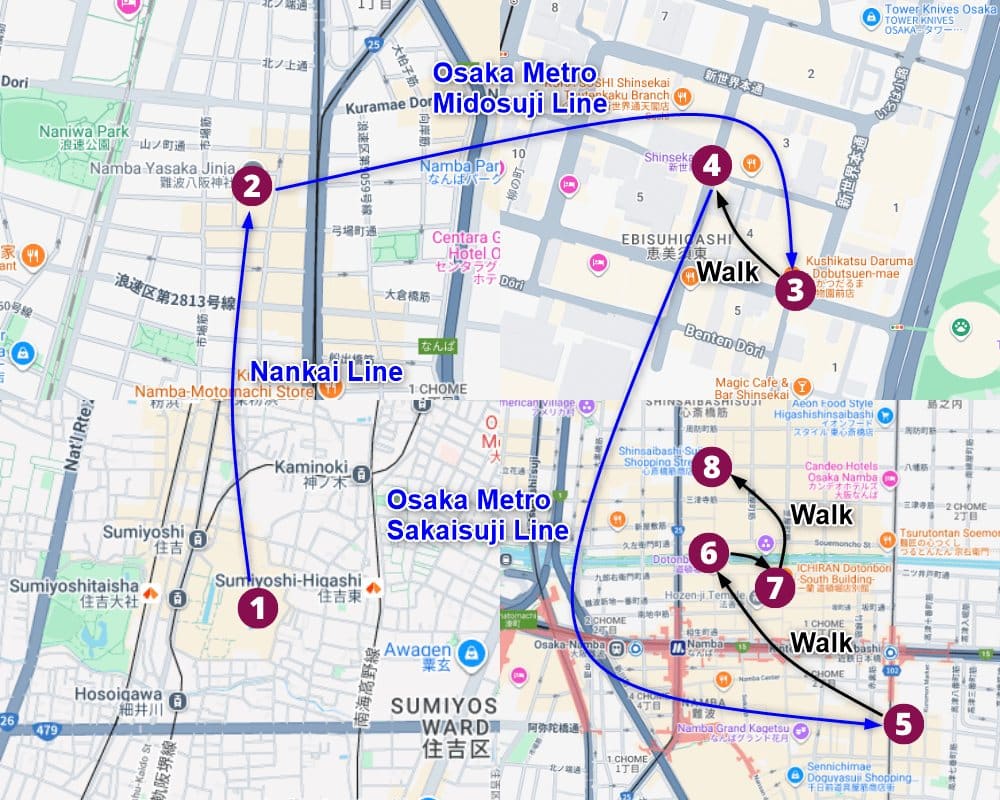
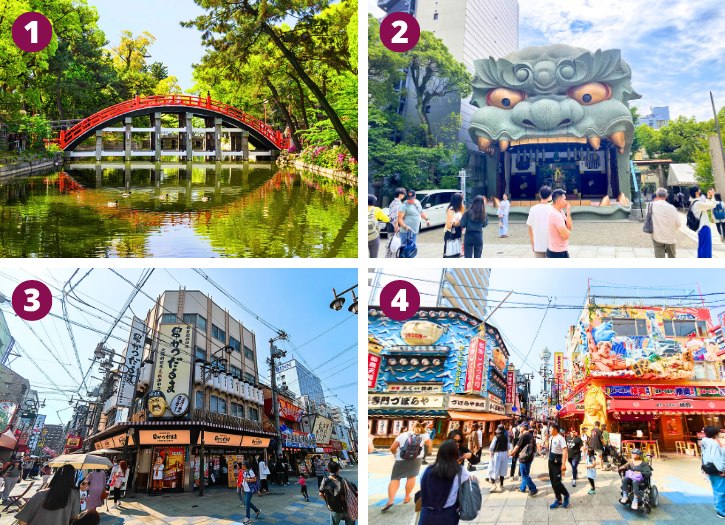
1. Sumiyoshi Taisha (9:00 AM)
- One of Japan’s oldest Shinto shrines
- Famous for unique architecture and arched bridges
- Peaceful garden grounds to explore
- Visit main shrine buildings and take photos of the scenery
2. Namba Yasaka Jinja (11:00 AM)
- Shinto shrine in Osaka with a giant 12-meter lion head structure
- Said to protect visitors by swallowing evil spirits
- Take photos in front of the lion head
- Pay respects at the main hall
- Write wishes on ema plaques or draw fortune slips (omikuji)
3. Kushikatsu Daruma – Lunch (12:00 PM)
- Specialty: Osaka-style deep-fried skewers (kushikatsu) with meat, seafood, and vegetables
- Must-try: New World Set (pork, shrimp, sausage, cheese chikuwa, veggies, Doteyaki stew) or Dotonbori Set (similar with Doteyaki)
- Dining Tip: Dip skewers ONCE ONLY in shared sauce (use provided cabbage for extra sauce)
- Budget: ¥1,700-2,800 per person
Alternative: Kura Sushi Shinsekai Tsutenkaku Branch
4. Shinsekai (1:00 PM)
- “New World” neighborhood built in 1912
- Famous for vibrant streets and the iconic Tsutenkaku Tower
- Colorful, nostalgic atmosphere with authentic local eateries
- Capture quirky photos with giant signs, lanterns, and the Billiken statue
- Try local favorites like kushikatsu, takoyaki, and doteyaki
- Stroll Janjan Yokocho, a lively street full of eateries and bars
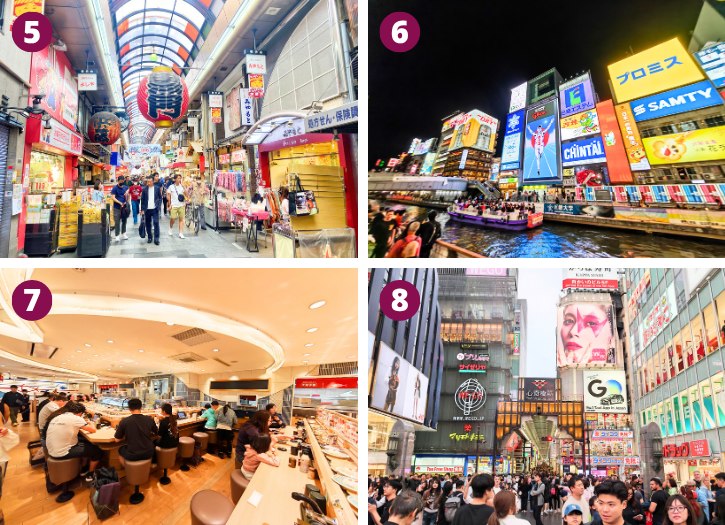
5. Kuromon Ichiba Market (3:00 PM)
- Known as “Osaka’s Kitchen” since 1902
- Covered market stretching 600 meters with over 150 shops and stalls
- Famous for fresh seafood, wagyu beef, street snacks, and daily supplies
- Fresh Seafood: Tuna, sashimi, scallops, oysters, crab legs
- Wagyu Beef Skewers: Kobe or Matsusaka beef, tender and juicy
- Sweets & Snacks: Strawberry daifuku, taiyaki, dorayaki
6. Dotonbori (5:00 PM)
Overview:
- Lively area along canal in Osaka
- Known for delicious food, bright neon signs, shopping, and nightlife
- Established over 400 years ago
- Originally famous for theaters and entertainment
- Osaka’s top food and nightlife district
Sightseeing Spots:
- Glico Running Man Sign: Iconic neon sign above Ebisubashi Bridge, a must for selfies
- Giant Signboards: Moving signs like the giant crab at Kani Doraku and dragon at Kinryu Ramen, perfect photo spots
- Ebisubashi Bridge & Dotonbori Canal: Pedestrian bridge with views of billboards and canal, great by day or night
- Hozenji Yokocho Alley & Temple: Lantern-lit street with traditional restaurants and the moss-covered Buddha statue
- Don Quijote Ferris Wheel (Ebisu Tower): Oval Ferris wheel on Don Quijote store, 15-minute ride with views over Dotonbori
- River Cruises: 20-minute boat rides along the canal, especially scenic at night
Read More: 17 Best Foods to Try at Dotonbori Osaka
7. Daiki-suisan Kaitenzushi – Dinner (6:30 PM)
- Specialty: Conveyor-belt sushi offering fresh, affordable sushi
- Must-try: Fresh Salmon, Scallops, Sea urchin (uni), Sweet Shrimp
- Budget: ¥100-700 per plate; average meal about ¥1,500-3,000 per person
Alternative: Dotonbori Kamukura Sennichimae | Hanamaruken Hozenji
8. Shinsaibashi-Suji Shopping Street (7:30 PM)
- Covered shopping arcade in Osaka featuring fashion stores, cosmetics shops, restaurants, and cafes
- Over 180 stores
- Vibrant atmosphere with bright lights, energetic crowds, lively shopping vibe
- Covered street provides comfort in any weather
Day 9: Osaka to Kyoto
Osaka to Kyoto (10:00 AM)
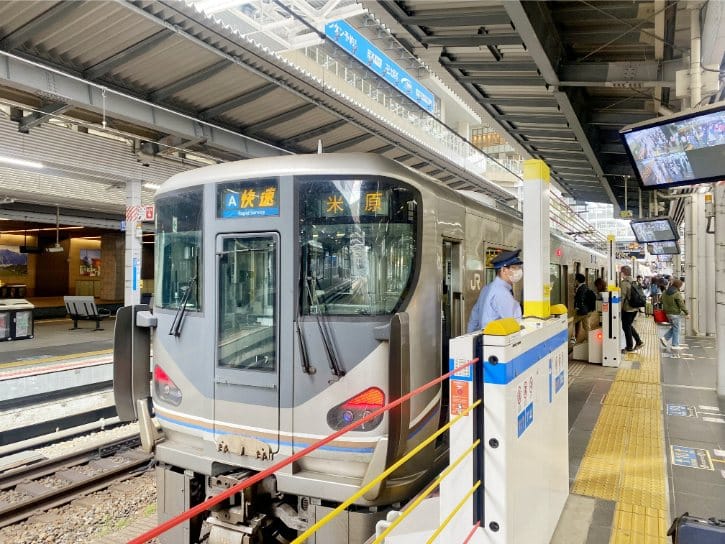
At Osaka Station, board JR Kyoto Line’s Special Rapid Service (also called Tokaido-Sanyo Main Line) bound for Kyoto. Journey takes about 30 minutes, costs ¥580.
Read More: Osaka to Kyoto: The Best Transport Options
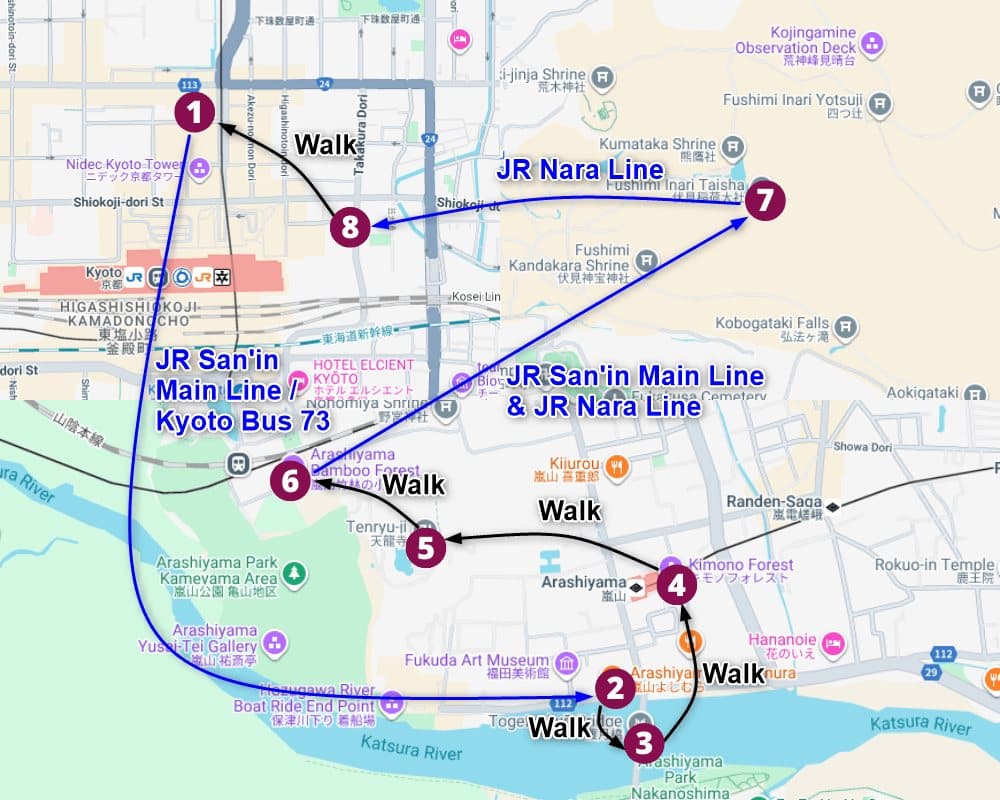
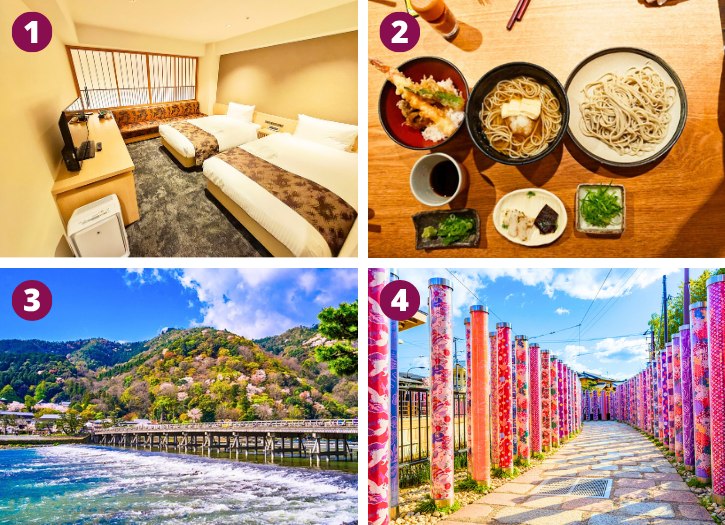
1. Check in at Daiwa Roynet Hotel Kyoto Ekimae PREMIER (10:30 AM)
- Located near Kyoto Station
- Convenient for transportation and exploring city
Read More: 10 Best Hotels in Kyoto
2. Arashiyama Yoshimura – Lunch (11:30 AM)
- Specialty: Handmade fresh soba noodles served hot or cold, prepared daily in-house
- Must try: Togetsuzen Set (two types of soba: Zaru and Yuba Oroshi, hot or cold, with crispy tempura rice and soba koji pickles), Soba Tea Roll (mini sponge cake with roasted soba tea and Hokkaido milk cream)
- Budget: ¥1,800–3,000 per person
3. Togetsukyo Bridge (12:30 PM)
- 155-meter “Moon Crossing Bridge” over the Katsura River
- Named by Emperor Kameyama after seeing the moon appear to cross the bridge
- Stunning river and mountain views in every season
- Famous for cherry blossoms in spring and colorful foliage in autumn
- Local shops and eateries nearby to explore
4. Kimono Forest (1:00 PM)
- Art installation at Randen Arashiyama Station with transparent pillars filled with kimono fabrics
- Illuminated at night, perfect for stunning photos
- Blends traditional kimono patterns with modern art to celebrate Kyoto’s heritage
- Wander among colorful kimono pillars around the station
- Visit Dragon Pond with its black stone sphere and golden dragon engraving, said to bring good fortune
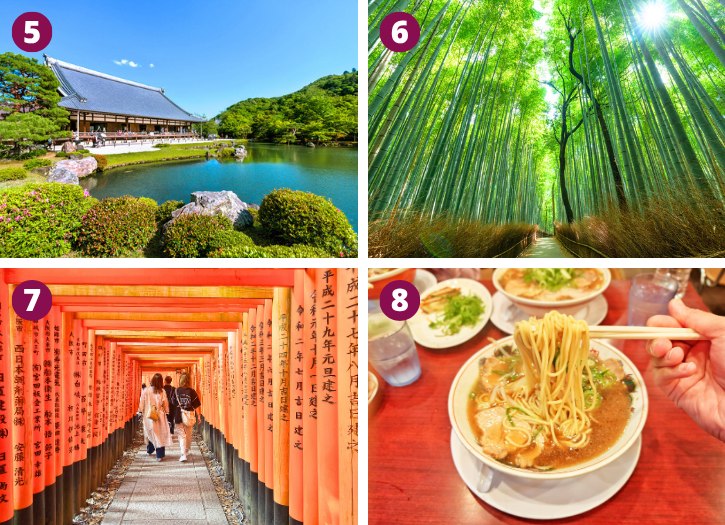
5. Tenryuji Temple (1:30 PM)
- UNESCO World Heritage Site and important Zen Buddhist temple in Kyoto
- Founded in 1339 by Shogun Asikaga Takauji
- Famous for its historic architecture and tranquil gardens
- Sogenchi Garden: Designed by Muso Soseki, features a calm pond at the center
- Hojo: Traditional building with beautiful interiors and garden views
- Hatto Hall: Known for its striking dragon painting on the ceiling
6. Arashiyama Bamboo Forest (3:00 PM)
- Famous natural bamboo grove in Kyoto’s Arashiyama district
- Pathways lined with towering bamboo stalks
- Centuries-old grove valued for construction, crafts, and cuisine
- Calming atmosphere with soft sunlight, rustling leaves, and great photo spots
- Explore:
- Short 300-meter main path
- Look up to appreciate the height of the bamboo
- Listen to the gentle sound of leaves in the wind
- Take your time to relax and enjoy, even if it gets crowded
7. Fushimi Inari Taisha (4:30 PM)
- Famous Shinto shrine in Kyoto dedicated to Inari, god of rice and prosperity
- Renowned for thousands of bright orange torii gates up Mount Inari
- Businesses donated gates over centuries, creating today’s iconic tunnels
- See & Do:
- Start at Romon Gate, a striking red entrance donated by Toyotomi Hideyoshi
- Explore the main shrine buildings, offer prayers, and learn about Inari
- Walk through the torii gate tunnels, keeping to the right for smooth flow
Tips: Best time to visit is early morning or late afternoon for fewer people
Read More: A Complete Guide to Fushimi Inari Taisha
8. Honke Daiichi-Asahi – Dinner (7:00 PM)
- Specialty: Kyoto-style ramen with soy-based pork broth, tender pork slices, green onions
- Must-try: Tokusei Ramen (Special Ramen) with double portion of pork and noodles, Gyoza dumplings
- Budget: ¥980 regular ramen, ¥1,180 special ramen, ¥320 gyoza; expect ¥1,000-1,500 per person
Day 10: Kinkakuji, Nishiki Market, Higashiyama and Kiyomizudera Temple (Kyoto)
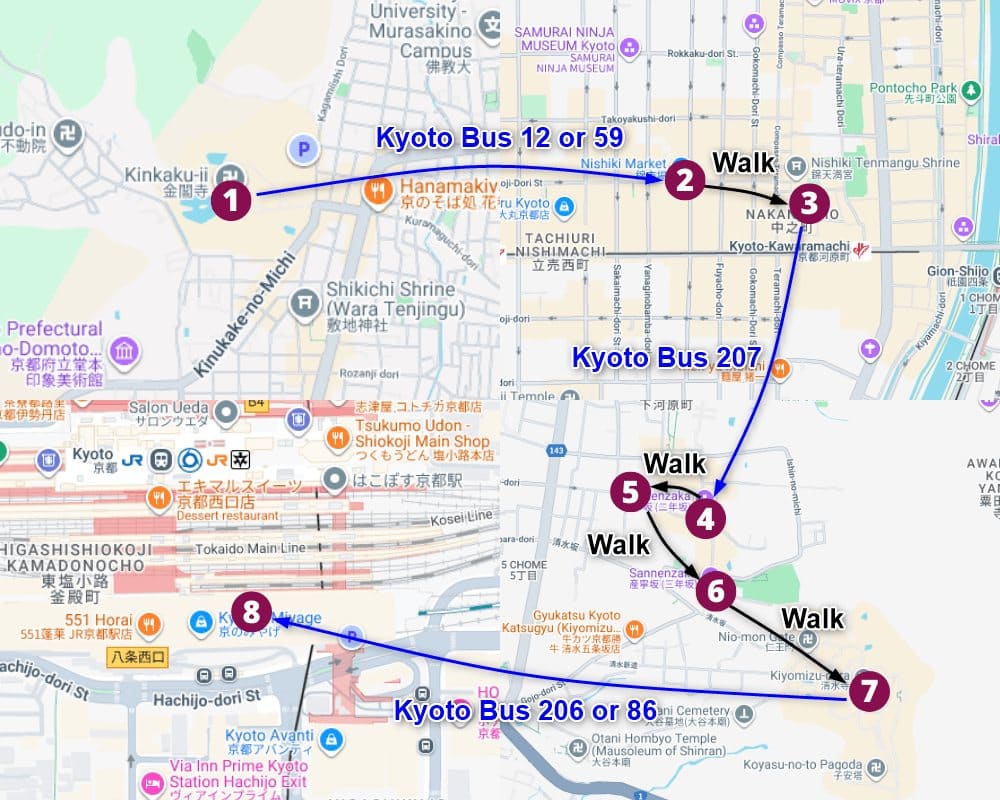
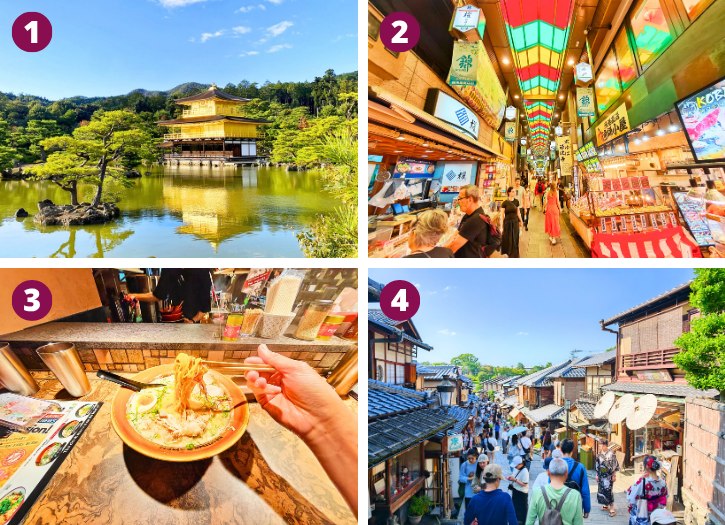
1. Kinkakuji Temple (9:00 AM)
- Zen Buddhist temple in Kyoto, one of the city’s most iconic landmarks
- UNESCO World Heritage Site and masterpiece of Japanese architecture and Zen garden design
- Golden Reflection: Admire the pavilion’s reflection in the pond, best viewed on calm, sunny days
- Coin Tossing for Luck: Try tossing coins at statues near Anmintaku Pond for protection and good fortune
2. Nishiki Market (11:15 AM)
- Nishiki Market – narrow five-block street known as “Kyoto’s Kitchen”
- Features over 100 shops and restaurants specializing in seafood, produce, knives, cookware, and Kyoto specialties
- Why Visit: Best place to experience Kyoto’s food culture, try street foods like tamago, skewered meats, and mochi, plus sample matcha sweets and tamagoyaki
- Atmosphere: Vibrant covered market, colorful displays, bustling yet traditional vibe
Must-Try Foods:
- Yuba Cream Croquette (Hanayori Kiyoe): Crispy outside, creamy tofu-skin filling
- Soy Milk Doughnuts (Konna Monja): Fluffy, slightly sweet, best enjoyed warm
- Dashimaki Tamago (Tanaka Keiran): Savory rolled omelet with dashi broth
- Tako Tamago (Kai): Grilled octopus stuffed with quail egg, glazed for flavor
- Unagi (Ajisai no Toyo): Charcoal-grilled eel with sweet soy glaze, served over rice
3. Kyoto Engine Ramen – Lunch (12:30 PM)
- Specialty: Ramen with three main types (Zesty spicy miso, Genuine Miso, Vegan), gluten-free noodles available (+¥200)
- Budget: Ramen dishes ¥1,400-1,900 per bowl; additional toppings ¥100-300; side dishes like miso seasoned rice ¥300, soup dumplings ¥800-1,000
Alternative: Gyukatsu Kyoto Katsugyu
4. Ninenzaka (2:00 PM)
Overview:
- Historic pedestrian street in Kyoto dating back to the Edo period
- Once a pilgrimage route to Kiyomizu-dera Temple
- Features traditional wooden machiya houses and stone-paved paths
- Why Visit: Experience old-world architecture, shop for local crafts, and enjoy authentic Kyoto cuisine
- Atmosphere: Nostalgic charm with preserved buildings, free of modern intrusions like power lines, perfect for leisurely walks and photos
Top Food Spots:
- Starbucks Kyoto Nineizaka Yasaka Chaya: Distinctive Starbucks with tatami-style seating, traditional Japanese ambiance
- Ishidatami: Renowned for premium soft-serve ice cream, especially indulgent matcha flavor with homemade sauce
- Fujinami Kodai-ji Temple Store: Authentic Kyoto-style sweets, handcrafted dango and mochi with high-quality ingredients
- Kasagiya: Historic sweet shop from Taisho era, classic treats like o-hagi (rice cakes) and zenzai (sweet bean soup)
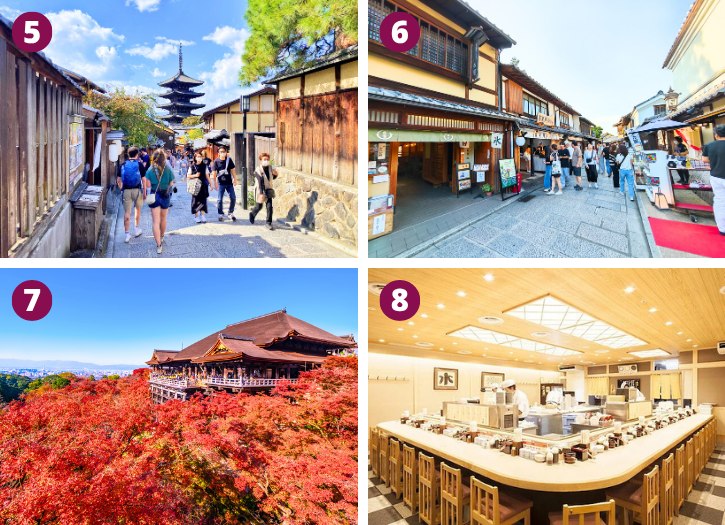
5. Yasaka Pagoda (3:00 PM)
- Historic five-story pagoda (Hokan-ji Temple)
- Over 1,400 years old, dating back to 6th century
- One of Kyoto’s most photographed scenes
- Perfect silhouette against traditional streets
6. Sannenzaka (3:10 PM)
Overview:
- Historic sloping street in Kyoto’s Higashiyama districtHistoric sloping street in Kyoto’s Higashiyama district
- Traditional wooden buildings and cozy shops
- Why Visit: Experience traditional Kyoto charm and take lovely photos of stone-paved paths and lanterns
- Atmosphere: Walking here feels like stepping into Kyoto’s past
Tasty Local Treats:
- Kirakuan Okamoto Sanneizaka: “Maiko-yaki” (geisha-shaped fried chicken)
- Fujinami: Tasty Kyoto-style treats, iced matcha, soy sauce-flavored dango
- Okutan Kiyomizu: Fresh handmade tofu, soy milk and black honey shaved ice
- Umezono Kiyomizu: Traditional sweet shop opened 1927, matcha sweets, shiratama zenzai, warabi mochi, seasonal sweets
- Ukiya Kiyomizu Kiseian: Handmade soba noodles, exceptional oyakodon with crispy fried shrimp
7. Kiyomizudera Temple (4:30 PM)
Overview:
- Historic Buddhist temple founded 778
- Current buildings from 17th century
- UNESCO World Heritage Site
- Famous wooden stage built without nails
- Dedicated to Kannon, goddess of mercy
Must-See Spots:
- Main Hall & Stage: Step onto the wooden stage for sweeping views of Kyoto, especially stunning during cherry blossom and autumn seasons
- Otowa Waterfall: Drink from one of three streams, each said to bring blessings of long life, success in studies, or luck in love (choose just one!)
- Three-Storied Pagoda: Bright red 31-meter pagoda, among the tallest in Japan, perfect for photos against the city backdrop
8. Sushi no Musashi Kyoto Station – Dinner (7:00 PM)
- Specialty: Conveyor-belt sushi with around 50 sushi types—fresh, affordable, casual atmosphere
- Budget: Most sushi plates cost ¥160, premium plates ¥400; typical spending ¥1,000-2,000 per person
Related Posts
Photo Credit:
Photos by PIXTA

